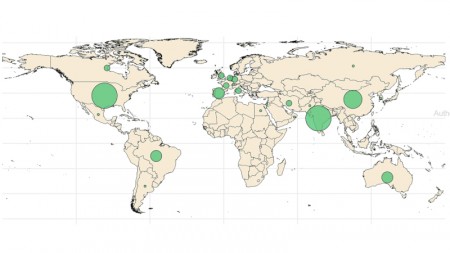

Location of the 100 most productive researchers (authors), grouped by country (image: Maurício Roberto Cherubin et al./Nature).
Regions most vulnerable to climate change and environmental degradation produce the least local knowledge on the subject.
Regions most vulnerable to climate change and environmental degradation produce the least local knowledge on the subject.

Location of the 100 most productive researchers (authors), grouped by country (image: Maurício Roberto Cherubin et al./Nature).
Agência FAPESP – In Brazil, researchers from the Luiz de Queiroz College of Agriculture at the University of São Paulo's Piracicaba campus (ESALQ-USP) and the Center for Carbon Research in Tropical Agriculture (CCARBON) have shown in a study that regions most vulnerable to climate change and environmental degradation produce the least local knowledge about soil health.
CCARBON is a FAPESP Research, Innovation, and Dissemination Center (RIDC) based at ESALQ-USP.
The study revealed that global scientific publications on soil health have increased significantly over the past decade, with 52% of articles published in the last five years and 74% in the last ten years. According to Maurício Roberto Cherubin, a professor at ESALQ-USP and CCARBON researcher, soil health is an emerging topic in Brazil and worldwide, attracting interest not only from academia, but also from the productive sector and government initiatives.
"Healthy soils perform multiple critical functions that sustain planetary and human health, enabling the production of food, fiber, and bioenergy, carbon sequestration, habitat for biodiversity, nutrient storage and cycling, and water regulation. These functions are crucial for maintaining ecosystem balance, increasing climate resilience, and ensuring long-term sustainability," Cherubin told the ESALQ-USP Press Office.
According to the study, this scientific research is primarily conducted in a few countries, including China, the United States, India, Brazil, and various European nations. Approximately 70% of the studies originate in the ten countries that publish the most in this area. These countries also have the greatest scientific cooperation among themselves and host the most productive researchers in the field.
The research data are detailed in an article published in Communications Earth & Environment.
The study also identifies the main "blind spots": regions with little or no research on soil health. These include Central and South America (excluding Brazil), Africa, Southeast Asia, and the Middle East. These regions are highly vulnerable due to high rates of deforestation, severe erosion, and loss of biodiversity. Additionally, they are among the regions most threatened by climate change.
Cherubin considers this aspect of the study to be one of the most critical: "How can we advance in terms of food security and combating climate change if the regions of the globe most vulnerable to these threats are precisely the ones with the greatest lack of information and the lowest investment in science? Consequently, these are areas with low capacity to generate technologies capable of reversing this scenario within a still viable timeframe, given the climate emergency we're experiencing."
To address this issue, the article's authors recommend prioritizing soil health in national agendas, such as the Brazilian Soil Health Partnership, as well as in international agendas. They suggest increasing investment, strengthening local research networks, and using simple, low-cost soil health monitoring tools.
The article "Global blind spots in soil health research overlap with environmental vulnerability hotspots" can be read at https://www.nature.com/articles/s43247-025-02663-w.
Republish
The Agency FAPESP licenses news via Creative Commons (CC-BY-NC-ND) so that they can be republished free of charge and in a simple way by other digital or printed vehicles. Agência FAPESP must be credited as the source of the content being republished and the name of the reporter (if any) must be attributed. Using the HMTL button below allows compliance with these rules, detailed in Digital Republishing Policy FAPESP.





